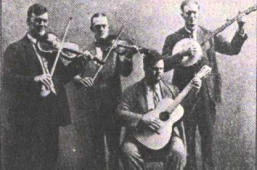About Appalachian Old Time Music
T
he
Appalachian
Mountains
stretch
some
1500
miles
(2400km),
from
the
Canadian
east
coast
to
central
Alabama
in
the
US
South.
Eastern
US
states
such
as
the
Carolinas,
Virginias,
Tennessee,
Kentucky,
Georgia
as
well
as
Southern
Pennsylvania
and
Southeast
Ohio
tend
to
be
the
most
significant in terms of Appalachian Old Time music culture.
This
is
the
music
that
originated
in
Ireland,
Scotland
and
England,
ballads
and
dance
tunes,
brought
by
Scotts-Irish
immigrants
who
settled
in
and
near
the
Appalachian
mountain
chain,
often
in
coal
country.
The
music
evolved
in
the
many
remote
rural
settlements
and
backwoods,
developing
its
own
character
and
variations.
Early
recordings
in
the
1920s
and
‘30s,
along
with
the
work
of
music
collectors
including
Cecil
Sharp
and
Alan
Lomax,
helped
reveal
and
spread
the
accumulated
riches of songs and tunes.
It
is
the
basis
for
the
musical
forms
that
developed
in
the
20th
century
such
as
‘country
music’,
‘bluegrass’
and
the
‘folk music revival’ that started in the 1960s.
Appalachian
music
intermingled
with
gospel
music
and
Afro-American
blues,
and
occasionally
absorbed
influences
from
other
ethnicities
that
had
migrated
to
rural
America,
such
as
from
Germany,
Scandinavia and Eastern Europe.
Early
recorded
Appalachian
musicians
include
the
Carter
family,
Clarence
Ashley,
Doc
Boggs,
Hobart
Smith,
Bascom
Lamar
Lunsford,
Fiddlin'
John
Carson,
Jimmie
Rodgers,
Charlie
Poole
and
Frank
Proffitt
initially
recorded
in
the
1920s
and
1930s.
Early
string
bands
included
Gid
Tanner’s
Skillet
Lickers
and
Humphrey
Bate
& the Possum Hunters.
After
the
Depression
and
WW2,
the
‘50s-‘60s
saw
new
names
come
to
prominence,
such
as
Doc
Watson,
Sam
&
Kirk
McGee
and
the
New
Lost
City
Ramblers
with
Mike
Seeger,
Tom
Paley
and John Cohen.
The
typical
instruments
played
in
string
bands
are
fiddles,
5-
string
banjo
(played
claw
hammer
or
2
or
3
finger
picking
style
but
not
bluegrass
style,
yet
to
be
invented
by
Earl
Scruggs)
with
guitar
picking
or
strumming,
and
double
or
tub
bass
accompaniment.
Other
instruments
played
in
Old
Time
include
the
mandolin,
harmonica,
piano,
Appalachian
dulcimer,
banjolin,
autoharp
and
percussion such as the spoons and washboard.
An
old-time
jam
differs
from
an
Irish
session
typically
by
playing
one
tune
at
a
time
rather
than
a
set
of
three,
,
and
staying
in
the
same
key
for
an
hour,
afternoon
or
even
a
day
to
avoid
re-tuning
the
fiddle
and
5-string
banjo.
Musicians
typically
learn
a
collection
of
tunes
in
the
major
keys,
and
work
through
those in a jam. As in an Irish session, songs may occasionally intersperse the tune-playing .
Appalachian
instrumental
music
was
primarily
to
accompany
dancers
at
local
weekly
barn
dances,
derived
as
it
is
from
Irish
and
Scots
reels.
There
are
individual
dance
styles
such
as
flat-foot
and
clogging,
but
mostly
people
participate
in
‘barn
dances’,
square
dances
and
contra-dancing.
The
caller
constantly
sings
out
the
dancer
instructions
while
the
string
band
provides
the
musical
backdrop.
Many
festivals
and
‘fiddlers
conventions’
are
staged
throughout
the
Appalachian
region.
The
Asheville
Mountain
Dance
and
Folk
Festival
was
started
in
1928.
The
biggest
is
Clifftop
in
West
Virginia,
where
over
5000
musicians
gather
yearly.”Old
Time”
festivals
can
be
found
during
the
warmer
months
from
New York to California.
Some links to musicians mentioned above:
Gid Tanner’s Skillet Lickers
Humphrey Bate & the Possum Hunters
Clarence Ashley
Fiddlin' John Carson
Doc Boggs
Charlie Poole
New Lost City Ramblers












